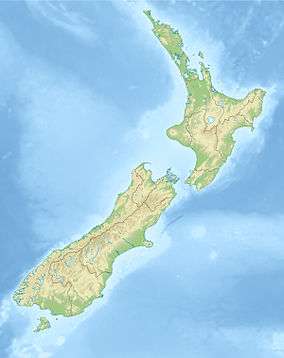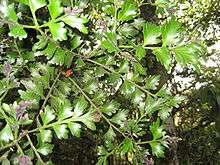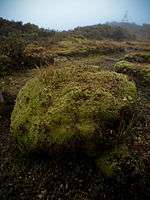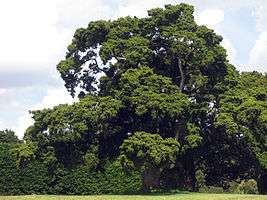Pureora Forest Park
| Pureora Forest Park | |
|---|---|
|
Pureora Forest Park | |
 Pureora National Park | |
| Location | North Island, New Zealand |
| Coordinates | 38°30′S 175°35′E / 38.500°S 175.583°ECoordinates: 38°30′S 175°35′E / 38.500°S 175.583°E |
| Area | 78,000 hectares (190,000 acres) |
| Established | 1978 |
| Governing body | Department of Conservation |
Pureora Forest Park is a 78,000-hectare (190,000-acre)[1] protected area in the North Island of New Zealand. Within its rich rain forest are an abundance of 1,000-year-old podocarp trees. It is "recognised as one of the finest rain forests in the world".[2] Established in 1978, after a series of protests and tree sittings, the park is one of the largest intact tracts of native forest in the North Island and has high conservation value due to the variety of plant life and animal habitats available. New Zealand's largest totara tree is located nearby on private land.
History
Anti-logging protests were led by conservation activists Stephen King, Shirley Guildford, and others in the late 1970s in what is now Pureora Forest Park. They had a novel way of erecting platforms on treetops, sitting over it to protest logging operations in the forests. The result of their efforts was tri-fold: the park was established in 1978; the Government of New Zealand changed rules to meet the protesters' demand to permanently stop logging operations; and the Native Forest Restoration Trust was formed which ensured that the park develops several areas into its present format.[1][3][4][5] One of the pine forest areas that was restored with native species of trees, with great efforts of Guildford, was named in her memory in 1988 a year after her death as the "Shirley Guildford Grove".[3][5]
Geography
Bounded by the Rangitoto and Hauhungaroa Ranges, Pureora Forest Park is situated between Lake Taupo and Te Kuiti. It is accessible from State Highway 45, which lies to the west of Lake Taupo.[6][7] Peaks include Mount Pureora (1,165 metres (3,822 ft)), the rock peak of Mount Titiraupenga (1,042 metres (3,419 ft)), and Mount Pukeokahu (844 metres (2,769 ft)).[8] They are popular among the bike trekkers and also the mountain hikers who use the mountain routes through the park to reach the peaks.
Within the park are Waihora Lagoon and Waihora Stream.[9] The Okahukura Stream is east of Okahukura Road.[8] The Waipa Mires can be seen from Select Loop Road.[10] There are several valleys within the park. These include the Mangakahu Valley, as well as the Tunawaea Valley southeast of Otorohanga.[9] The Maramataha Valley is located in the southwestern part of the park and the nearby Maramataha River is impassable in high water.[11]

A buried, subfossil forest that had been submerged under pumice after the eruption of Taupo crater (c. AD 186) was discovered in 1983.[12][13] The way the trees fell following the eruption is still evident, with the large tree trunks lying in rows.[5][6][14]
Fauna and flora
Lower altitudes are characterized by tawa and tree ferns, as well as tall native trees, including kahikatea, matai, miro, rimu, and totara. The Pouakani Totara tree, New Zealand's tallest totara, is located east of the Field Centre.[5] The giant totara, rimu, matai, miro and kahikatea trees tower 40–60 metres, and belong to an ancient family of trees dating from the dinosaur era.[13] Higher altitudes include kamahi and Hall's totara; sub-alpine herbs are abundant near the peaks.[7] Grasses within the park include toetoe.[11] The Pouakani Totara Tree is the largest recorded totara tree in New Zealand and is located just outside the park in the Wairapara Moana Incorporation reserve, located on the SH30 road.[14]

The feral house mouse has a significant population within the park.[15] There is rich native bird life in this forest including the rare North Island kōkako and the kaka, kākāriki, kuku (kereru, a native pigeon), and North Island robin. Sika deer have been shot or sighted within the confines of the park, believed to be an illegal liberation.[16] Pigs are present,[17] and of the at least eleven pest species that co-exist within the park, possums and goats are subject to management operations.[18]
Tourism
Camping, picnicking, swimming, and mountain biking (e.g. the Timber Trail opened in 2013) are popular within the park's confines.[6] And the Pureora Forest Park Hunting Competition has brought hunters to the area since 1987.[19]
There are many areas in the park that are interesting to both tourists and scientists. The Forest Tower is a 12-metre-tall tower located about ten minutes by foot from the Bismarck Road car park. Popular with ornithologists, birds such as kuku, kakariki, and kaka are evident in the area.[1][7][14] The 1978 Treetop Protest Site is still accessible today and includes platforms high in the trees.[14] A 1940s steam hauler, used to transport logs through the forest for milling, and a 2-tonne Caterpillar tractor are still present in the reserve; the latter was used in the 1950s to harvest many totara for posts.[14]
 The Pureora forest |
 Podocarpus totara found in Pureora Forest Park |
 Forests in Pureora |
 Tall trees in Pureora forest area |
See also
References
- 1 2 3 Rawlings-Way, Charles; Atkinson, Brett; Bennett, Sarah (1 October 2010). Lonely Planet New Zealand. Lonely Planet. pp. 301–. ISBN 978-1-74179-473-1. Retrieved 1 January 2011.
- ↑ "Forest Parks: Pureora". New Zealand's Information Network.
- 1 2 "Our history". nznfrt.org.nz. NZ Native Forests Restoration Trust.
- ↑ "Trees crash near totara campers as logging starts". Auckland Star. 19 January 1978.
- 1 2 3 4 "Pureora Forest Park". sirowaw.net.nz. Retrieved 1 January 2011.
- 1 2 3 "Mountain biking Pureora". doc.govt.nz. Department of Conservation. Retrieved 1 January 2011.
- 1 2 3 "Parks & Reserves – Pureora Forest Park". newzealand.com. New Zealand Tourism Board. Retrieved 1 January 2011.
- 1 2 "Okahukura Loop". Department of Conservation. Retrieved 1 January 2011.
- 1 2 "Pureora mountain biking areas". Department of Conservation. Retrieved 1 January 2011.
- ↑ "Select Loop Road". conservation.gen.nz. Retrieved 1 January 2011.
- 1 2 "Waione Tram Mountain Bike Track". Department of Conservation. Retrieved 1 January 2011.
- 1 2 Palmer, J.G.; Ogden, J.; Patel, Rajni N. (December 1988). "A 426-year floating tree-ring chronology from Phyllocladus trichomanoides buried by the Taupo eruption at Pureora, central North Island, New Zealand". Journal of the Royal Society of New Zealand. The Royal Society of New Zealand. 18: 407–15. doi:10.1080/03036758.1988.10426465. Retrieved 1 January 2011.
- 1 2 DeHek, Danny. "Forest Parks – Pureora". newzealandnz.co.nz. Retrieved 1 January 2011.
- 1 2 3 4 5 "Pureora Forest Park" (PDF). Department of Conservation. Retrieved 1 January 2011.
- ↑ New Zealand. Dept. of Scientific and Industrial Research (2007). New Zealand journal of zoology. Dept. of Scientific and Industrial Research. p. 183. Retrieved 1 January 2011.
- ↑ McCullough, Dale R.; Takatsuki, Seiki (24 December 2008). Sika Deer: Biology and Management of Native and Introduced Populations. シュプリンガー・ジャパン株式会社. p. 649. ISBN 978-4-431-09428-9. Retrieved 1 January 2011.
- ↑ "Hunting". conservation.gen.nz. Retrieved 1 January 2011.
- ↑ Coleman, J.D. (March 1974). "The integration of management of vertebrate pests in new Zealand". New Zealand Journal of Zoology. The Royal Society of New Zealand: 341–. doi:10.1080/03014223.1993.10420356. Retrieved 1 January 2011.
- ↑ "Pureora Forest Park Hunting Competition 2010 – a roaring success!". doc.govt.nz. Retrieved 1 January 2011.
External links
| Wikimedia Commons has media related to Pureora Forest Park. |
- Department of Conservation – Pureora Forest Park
- New Zealand Tramper – Pureora Forest Park
- World Database on Protected Areas – The Pureora Forest Park Conservation Park datasheet

